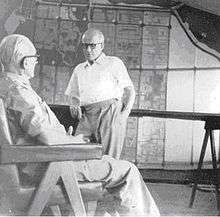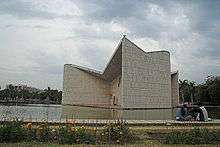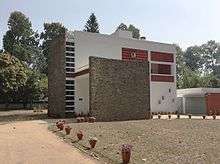Pierre Jeanneret
| Pierre Jeanneret | |
|---|---|
 | |
| Born |
22 March 1896 Geneva, Switzerland |
| Died | 4 December 1967 (aged 71) |
| Occupation | Architect |
| Buildings | Gandhi Bhawan, Chandigarh |
| Projects | Chandigarh's huge civic architecture project |
Pierre Jeanneret (22 March 1896 – 4 December 1967) was a Swiss architect who collaborated with his cousin, Charles Edouard Jeanneret (who assumed the pseudonym Le Corbusier), for about twenty years.
Early life
Arnold Andre Pierre Jeanneret-Gris was born in Geneva. He grew up in the typical Jura landscape that influenced his early childhood and his Geneva Calvinism roots. He attended the School of Fine Arts (Ecole des Beaux-Arts, Geneva).[1] As a young student, he was a brilliant painter, artist and architect, greatly influenced by Charles Edouard Jeanneret (Le Corbusier), his cousin and mentor for life. He was a cyclist in the Swiss Army from 1916 to 1918.
Career
In 1922, the Jeanneret cousins set up an architectural practice together. They designed many buildings, including a number of villas and vacation houses,[2] and renovated existing buildings as well.[3]
Their working relationship ended when Pierre joined the French Resistance and Le Corbusier did not. However, they collaborated once again after the War, on the plan and architecture for the city of Chandigarh in India.

Chandigarh


Jeanneret, in collaboration with the English husband-wife team of Maxwell Fry and Jane Drew, was responsible for much of Chandigarh's large civic architecture project. His most remarkable contribution has undoubtedly been the designing of the fourteen categories of mass-housings that constitute the living and amenity areas of Chandigarh. Jeanneret, along with Ar. Jugal Kishore Chowdhary, Ar. Bhanu Pratap Mathur and Er. Agya Ram, was responsible for a significant amount of designing for the Panjab University, including the Gandhi Bhawan and the University Library.
Jeanneret stayed on in Chandigarh after its construction, advising the local government in his appointed capacity as Chief Architect of the city. In order to commemorate his legacy, the Chandigarh Administration has restored his residence, House No. 57, Sector 5 (Type 4J), and converted it into a Museum dedicated to his contributions to the city, on his 121st Birth Anniversary i.e. March 22, 2017.[4]
Equally significant was his role as a mentor to young Indian architects like Aditya Prakash, Jeet Malhotra, Shiv Datt Sharma, and JK Chowdhary[5].
Some of his major works in Chandigarh include the M.L.A. Hostels in Sector 3 and 4, Polytechnic for Men (now CCET) in Sector 26, the State Library, Town Hall and the Post & Telegraph Building in Sector 17, the Architects' Office (now Le Corbusier Centre) in Sector 19, the P.G.I.M.E.R. in Sector 12 (in collaboration with Jeet Malhotra, Aditya Prakash and H.S.Chopra), Government Model Senior Secondary School, Sector-16, St. John's High School, Sector 26 and the Shops on V4 in Sector 11.[6]
Furniture
As well as buildings, Jeanneret also designed furniture, both independently and with Le Corbusier.[7][8] He experimented with minimalist design, including a chair which required no fasteners.
Death
On his death, 4 December 1967, in accordance with his will, Jeanneret's ashes were scattered in Chandigarh's Sukhna Lake.
See also
References
- Notes
- ↑ "Suiss Historical Enceclopedia". Historisches Lexikon der Schweiz. Retrieved 20 May 2016.
- ↑ Richard A. Etlin (1994). Frank Lloyd Wright and Le Corbusier: The Romantic Legacy. Manchester University Press. pp. 7–. ISBN 978-0-7190-4061-0.
- ↑ Jacques Sbriglio (1 January 1996). Apartment Block 24 N. C. and LeCorbusier's Home. Springer Science & Business Media. pp. 98–. ISBN 978-3-7643-5432-9.
- ↑ "Badnore opens Pierre Jeanneret museum". Tribuneindia.com. Retrieved 14 October 2017.
- ↑ Scriver, Peter; Srivastava, Amit (2015-02-15). India: Modern Architectures in History. Reaktion Books. ISBN 9781780234687.
- ↑ Joshi, Kiran (1999). Documenting Chandigarh: the Indian Architecture of Pierre Jeanneret, Edwin Maxwell Fry, Jane Beverly Drew (Vol. 1). Ahmedabad: Mapin Publishing.
- ↑ Sarbjit Bahga; Surinder Bahga (2000). Le Corbusier and Pierre Jeanneret: Footprints in the Sand of Indian Architecture. Galgotia. p. 35. ISBN 978-81-85989-45-7.
- ↑ Volker Fischer (1999). The LC4 Chaise Longue by Le Corbusier, Pierre Jeanneret and Charlotte Perriand. Verlag form.
- Sources
- Documenting Chandigarh: The Indian Architecture of Pierre Jeanneret, Edwin Maxwell Fry, Jane Beverly Drew, by Kiran Joshi, Grantha Corporation, 1999. ISBN 1-890206-13-X.
- Sarbjit Bahga, Surinder Bahga (2014) Le Corbusier and Pierre Jeanneret: The Indian Architecture, CreateSpace, ISBN 978-1495906251
- Tim Benton (2007). The Villas of Le Corbusier and Pierre Jeanneret 1920-1930. Springer. ISBN 978-3-7643-8406-7.
External links
- Pierre Jeanneret archive at the Canadian Centre for Architecture
- Pierre Jeanneret, furniture for Chandigarh